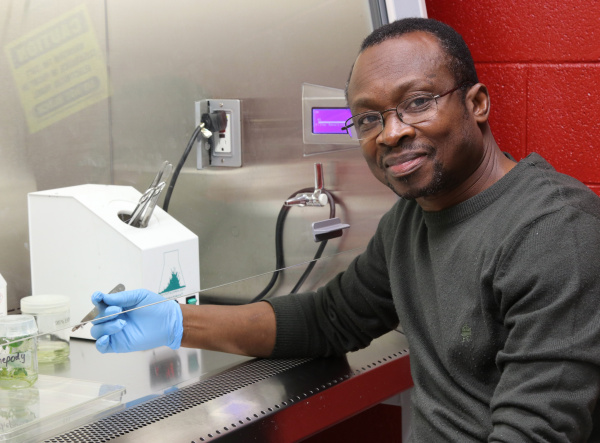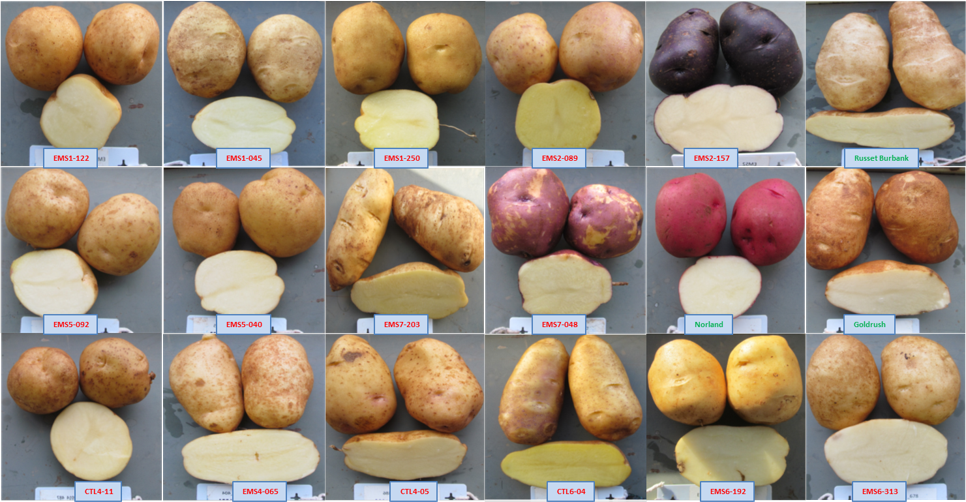For more information
Media Relations
Agriculture and Agri-Food Canada
1-866-345-7972
aafc.mediarelations-relationsmedias.aac@agr.gc.ca
While browsing the vegetable aisle at your local grocery store, you may have wondered how many different types of potatoes we have today. Fun fact: there are more than 5,000 potato varieties worldwide. Potato genetics research and potato breeding have not only increased the various types of potatoes we have available at the grocery store, like white, red, yellow or purple, it is helping farmers achieve higher yields by allowing them to plant varieties that are adapted to modern growing conditions.
Typically, breeders have focused on traditional potato varieties, like Russet Burbank, used for French fries. These commercial varieties are of tetraploid origin because they have four copies of each chromosome in their DNA – two copies inherited from each plant parent. Humans and most other animals are diploid – we have two copies of each chromosome, one from each parent. Breeding science is evolving, and because of the vast number of tetraploid potato varieties we have, they became closely related to one another, with the genetic difference between each decreasing. Decreased genetic diversity leads to varieties being more vulnerable to different diseases and being less adapted to climate change. Additionally, having biodiversity is very important in the breeding process. To increase the genetic diversity, breeders use wild potato relatives that are tetraploid or diploid. Wild diploid potatoes also have two copies of each chromosome in their DNA, making their genetics easy to work with. As a result, they are becoming promising for geneticists and breeders to develop new diploid potato varieties. First domesticated in the Andes of South America, diploid potatoes are often a little smaller in size than their tetraploid cousins. But where they lack in size, they more than make up for in breeding potential because of their hidden and unexplored genetic traits.
Eyeing diploid potatoes for breeding
Agriculture and Agri-Food Canada (AAFC) research scientist Dr. Bourlaye Fofana has been studying potato germplasm for many years at the Charlottetown Research and Development Centre on Prince Edward Island. Germplasm are the seeds, plants, or plant parts used in crop breeding, research, and conservation efforts. Dr. Fofana’s work is among the first step in the process of researching promising potato clones that will be further studied by the AAFC potato breeding program at their headquarters in Fredericton, New Brunswick. He is excited by the prospect of using diploid potatoes in crop genetics and potato breeding.
“There is a natural genetic diversity in wild diploid potatoes compared to tetraploids that make them interesting for breeding. We can find characteristics in diploids, like drought resistance, that are not in the tetraploid potatoes we already grow in Canada.”
-Dr. Bourlaye Fofana, Research Scientist, Agriculture and Agri-Food Canada
Dr. Fofana set out to accomplish three goals – to identify diploids that may become commercial potato varieties in the future, develop true potato seeds from diploids, and identify genetic markers in diploids that can be used to improve tetraploid potatoes through breeding. As it turns out, the third objective would be the first Dr. Fofana peeled into.
Peeling away DNA to find the promising genetic markers
Dr. Fofana, along with AAFC researchers in Charlottetown, Prince Edward Island, and Kentville, Nova Scotia, as well as former AAFC student Dr. Braulio Soto-Cerda, now at the Universidad Católica de Temuco in Chile, evaluated 384 diploid potato clones for drought tolerance and plant maturity characteristics. Using genome DNA analysis, they found genetic DNA markers that were associated with plant growth and drought-resistant characteristics. These markers play key roles in plant development and aging, as well as the ability to respond positively to environmental stresses like drought. Of the 384 diploid clones, the group found 127 that are late-maturing and tolerant to drought conditions, and nine clones that were early to moderate-late maturing and tolerant to drought.
“This research is very promising and we’ve even seen diploids that are outperforming some tetraploid potatoes under normal growing conditions. If we can develop a commercial diploid or tetraploid potato variety that is early or moderate-late maturing for a relatively short growing season with drought resistance, it would be well-received by Canadian potato producers.”
- Dr. Bourlaye Fofana, Research Scientist, Agriculture and Agri-Food Canada
Approximately 50 of the most promising diploid clones for yield and tuber quality characteristics from the group will continue to the next stage characterization in the breeding process with Dr. Benoit Bizimungu, an AAFC research scientist at the Fredericton Research and Development Centre. Dr. Bizimungu is preserving some of them in the Canadian Potato Gene Resources collection and will evaluate each for potato size, shape, yield potential, cooking and processing traits. Following this evaluation, they may be released as diploid potato varieties or used as germplasm in the potato breeding pipeline with Dr. David De Koeyer.
So far, Dr. Fofana’s research is an important first step. It shows that genes associated with drought tolerance can be developed, and that the markers, gene sequences, and the 50 selected clones are key resources for breeders to make future potato varieties more resilient to climate change.
Key discoveries and benefits
- With the vast number of tetraploid (four chromosome) potato varieties available, the genetic difference between each is decreasing. That has led to older, wild potato germplasm called diploids, because they have two copies of chromosomes, becoming promising varieties for geneticists and breeders at Agriculture and Agri-Food Canada (AAFC).
- Dr. Bourlaye Fofana, along with AAFC researchers in Charlottetown, Prince Edward Island, and Kentville, Nova Scotia, as well as former AAFC student Dr. Braulio Soto-Cerda, now at the Universidad Católica de Temuco in Chile, evaluated 384 diploid potato clones for drought tolerance and plant maturity characteristics.
- Of the 384 diploid clones, the group found 127 that are late-maturing and tolerant to drought conditions and nine clones were early to moderate-late maturing and tolerant to drought.
- Dr. Fofana’s research is an important first step. It shows that genes associated with drought tolerance can be developed, and that the markers, gene sequences, and the 50 selected clones are key resources for breeders to make future potato varieties more resilient to climate change.
Photo gallery

Dr. Bourlaye Fofana and his team’s discovery of drought-resistance genes in diploid potatoes is an important first step in the potato variety breeding process.

Various tetraploid and diploid potato varieties being evaluated for diversity including shape, colour and size.